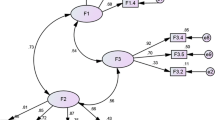Abstract
Identifying patients’ expectations of and need for healthcare chaplaincy is important in terms of appropriate intervention. Therefore, a sample of 612 patients from 32 general hospitals and psychiatric clinics in the German part of Switzerland was surveyed about their expectations of chaplaincy service. A principal component factor analysis of participants’ ratings found that the survey items fell into three distinct categories. These were the need for (1) emotional support, (2) help to cope with illness/disease, and (3) religious/spiritual assistance. Among the expectations, the need for emotional support was rated most important, followed by help to cope and, lastly, religious/spiritual assistance. Gender, religious denomination, general religiosity, and subjective health status significantly influenced these expectations. The results showed that fulfilling patients’ expectations increases their overall satisfaction with, and the importance they accord to the chaplain’s visit, as well as their confidence in the chaplain.
Similar content being viewed by others
References
Acock, A. (1997). Working with missing data. Family Science Review, 1, 76–102.
Beck, U. (1992). Risk society. Towards a new modernity. London: Sage.
Bjorck, J. P., & Thurman, J. W. (2007). Negative life events, patterns of positive and negative religious coping, and psychological functioning. Journal for the Scientific Study of Religion, 46(2), 159–167.
Bührlen, B., Gerdes, N., & Jäckel, W. H. (2005). Entwicklung und psychometrische Testung eines Patientenfragebogens für die medizinische Rehabilitation (IRES-3). Rehabilitation, 44, 63–74.
Duffy, J., & Munro, G. (2005). Measuring the effectiveness of chaplaincy: What to audit. Scottish Journal of Healthcare Chaplaincy, 8(2), 9–13.
Fitchett, G. (2002). Health care chaplaincy as a research-informed profession: How we get there. Journal of Health Care Chaplaincy, 12, 67–72.
Fitchett, G., Meyer, P. M., & Burton, L. A. (2000). Spiritual care in the hospital: Who requests it? Who needs it? Journal of Pastoral Care, 54(2), 173–186.
Flannelly, K. J., Galek, K., Tannenbaum, H. P., & Handzo, G. F. (2007). A preliminary proposal for a scale to measure the effectiveness of pastoral care with family members of hospitalized patients. The Journal of Pastoral Care & Counseling, 61(1–2), 19–29.
Fox-Wasylyshyn, S. M., & El-Masri, M. M. (2005). Handling missing data in self-report measures. Research in Nursing and Health, 28, 488–495.
Frick, E., Riedner, C., Fegg, M. J., Hauf, S., & Borasio, G. D. (2005). A clinical interview assessing patients’ spiritual needs and preferences. European Journal of Cancer Care, 15, 238–243.
Galek, K., Flannelly, K. J., Vane, A., & Galek, R. M. (2005). Assessing a patient’s spiritual needs: A comprehensive instrument. Holistic Nursing Practice, 19(2), 62–69.
Giaimo, S. (2002). Markets and medicine: The politics of health care reform in Britain, Germany and the United States. Ann Arbor: The University of Michigan Press.
Gray, A. M. (2007). European health care costs. Social Policy and Administration, 18(3), 213–228.
Harrison, M. (2004). Implementing change in health systems. Market reforms in the United Kingdom, Sweden and the Netherlands. London: Sage.
Lublewski-Zienau, A., Kittel, J., & Karoff, M. (2003). Was erwarten Patientinnen und Patienten von der Klinikseelsorge?—Eine Studie in der kardiologischen Rehabilitation. Wege zum Menschen, 55(7), 463–478.
Lublewski-Zienau, A., Kittel, J., & Karoff, M. (2005). Religiosität, Klinikseelsorge und Krankheitsbewältigung. Wege zum Menschen, 57(4), 283–295.
McIntosh, D. N., Silver, R. C., & Wortman, C. B. (1993). Religion’s role in adjustment to negative life event: Coping with the loss of a child. Journal of Personality and Social Psychology, 65, 812–821.
Mitchell, D., & Sneddon, M. (1999). Spiritual care: Informing the debate: Chaplaincy and spiritual care in Scotland. International Journal of Palliative Nursing, 5(6), 275–280.
Mowat, H., & Swinton, H. (2007). What do chaplains do?. The role of the chaplain in meeting the spiritual needs of patients. Report No. CSHD/MR001. Aberdeen: Mowat Research Limited.
Pargament, K. I., Smith, B. W., Koenig, H. G., & Perez, L. (1998). Patterns of positive and negative religious coping with major life stressors. Journal for the Scientific Study of Religion, 37(4), 710–724.
Pargament, K. I., Tarakeshwar, N., Ellison, C. G., & Wulff, K. M. (2001). Religious coping among the religious: The relationships between religious coping and well-being in a national sample of Presbyterian clergy, elders, and members. Journal for the Scientific Study of Religion, 40, 497–513.
Park, C. L. (2005). Religion as a meaning-making framework in coping with life stress. Journal of Social Issues, 61, 707–724.
Piderman, K. M., Marek, D. V., Jenkins, S. M., Johnson, M. E., Buryska, J. F., & Mueller, P. S. (2008). Patients’ expectations of hospital chaplains. Mayo Clinical Proceedings, 83(1), 58–65.
Pollack, D. (1996). Zur religiös-kirchlichen Lage in Deutschland nach der Wiedervereinigung. Eine religionssoziologische analyse. Zeitschrift für Theologie und Kirche, 93, 586–615.
Swiss Federal Statistical Office. (2003). Schweizer Religionslandschaft im Umbruch. Eidgenössische Volkszählung 2000. Retrieved from http://www.bfs.admin.ch/bfs/portal/de/index/infothek/lexikon/bienvenue___login/blank/zugang_lexikon.topic.1.html.
Wohlleben, E. (2004). Die Kirchen und die Religionen. Perspektiven einer ökumenischen Religionstheologie. Göttingen: Vandehoeck & Ruprecht.
Wright, M. C. (2001). Chaplaincy in hospice and hospital: Findings from England and Wales. Palliative Medicine, 15, 229–242.
Acknowledgments
The authors gratefully acknowledge the financial support of the Catholic and the Protestant Chaplaincy Associations of the German part of Switzerland.
Author information
Authors and Affiliations
Corresponding author
Rights and permissions
About this article
Cite this article
Winter-Pfändler, U., Flannelly, K.J. Patients’ Expectations of Healthcare Chaplaincy: A Cross-Sectional Study in the German Part of Switzerland. J Relig Health 52, 159–168 (2013). https://doi.org/10.1007/s10943-010-9451-7
Published:
Issue Date:
DOI: https://doi.org/10.1007/s10943-010-9451-7




